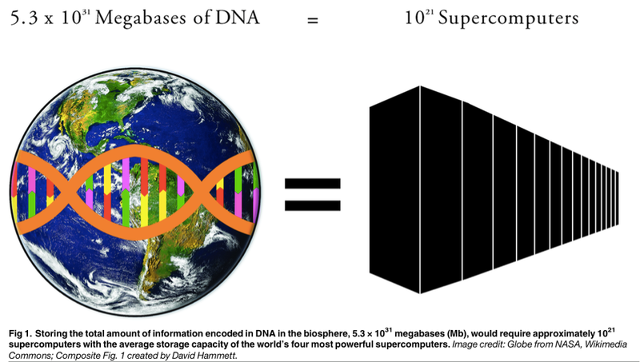the first-Ever Sum Of all of the DNA on the earth Will Boggle Your thoughts
you’d need 1 billion trillion supercomputers to store all that code.
June 11, 2015
if you happen to have been to store all the knowledge contained in all of the DNA of every organism on earth, you would wish to find a pretty big data-farm. it could require the equivalent capacity of 1 billion trillion supercomputers, according to a a new estimate—the primary to count the entire genetic code in the world.
Fifty trillion trillion trillion “base pairs”—the chemical letters making up genetic code—underpin all dwelling issues, say Hanna Landenmark, Duncan Forgan and Charles Cockell, authors of a paper published within the journal Plos Biology. All of this DNA weighs 50 billion metric heaps and is sufficient to fill 1 billion transport containers.
the purpose of the estimate is not trivial pastime. it is a step in seeing the “biosphere” as an informational device, with possible implications for all forms of science, say the authors. “The biosphere may also be visualized as a large, parallel supercomputer, with the information storage represented with the aid of the entire amount of DNA and the processing power symbolized by means of [gene expression] charges,” they write. “In analogy with the web, all organisms on the planet are person containers of knowledge related through interactions and biogeochemical cycles in a large, world, bottom-up network.”

Landenmark, Forgan and Cockell advise an “different way of quantifying and figuring out biodiversity” based totally round counting the whole DNA in an area, rather than counting up species and the number of individuals representing these species. “The corresponding action within the electronic laptop analogy would be to attempt to estimate the guidelines content material of the internet by counting the choice of fashions and choice of computer systems hooked up to it,” they are saying of present biodiversity calculation efforts.
to reach their numbers, the researchers split dwelling issues into five categories: prokaryotes (single cell organisms), crops, animals, unicellular eukaryotes, and fungi, then estimated biomass, choice of folks, and DNA densities.
The way isn’t very poetic. It reduces human beings to nothing but “containers, inside which the guidelines that underpins the functioning of the biosphere is saved as DNA.” but they say this may be useful for understanding how the biosphere has changed over time, or could alternate one day.
quick company , read Full Story
(95)














